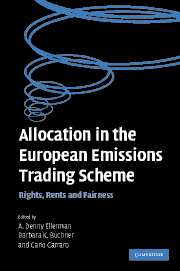Book contents
- Frontmatter
- Contents
- List of figures
- List of boxes
- List of tables
- List of contributors
- Introductory note/Foreword
- Acknowledgements
- Glossary and abbreviations
- Part I The EU ETS allocation process
- Part II Experiences from Member States in allocating allowances
- 3 United Kingdom
- 4 Germany
- 5 Denmark
- 6 Sweden
- 7 lreland
- 8 Spain
- 9 Italy
- 10 Hungary
- 11 Czech Republic
- 12 Poland
- Part III Concluding remarks and background material
- Appendix I Participants
- Appendix II The individual country outlines
- Appendix III The country tables
- Appendix IV Background material from the European Commission
- Index
11 - Czech Republic
Published online by Cambridge University Press: 22 September 2009
- Frontmatter
- Contents
- List of figures
- List of boxes
- List of tables
- List of contributors
- Introductory note/Foreword
- Acknowledgements
- Glossary and abbreviations
- Part I The EU ETS allocation process
- Part II Experiences from Member States in allocating allowances
- 3 United Kingdom
- 4 Germany
- 5 Denmark
- 6 Sweden
- 7 lreland
- 8 Spain
- 9 Italy
- 10 Hungary
- 11 Czech Republic
- 12 Poland
- Part III Concluding remarks and background material
- Appendix I Participants
- Appendix II The individual country outlines
- Appendix III The country tables
- Appendix IV Background material from the European Commission
- Index
Summary
Introductory background and context
Czech industry in the context of economic development
The Czech Republic is a relatively industrialised country with a higher share of industrial activity than its closest neighbours. The carbon consequences are aggravated by the relatively poor quality of the available coal which is used in the power sector. Higher-quality black coal, which is also available in smaller quantities, is mostly used for the production of coke and for the blast furnaces in the steel industry. These factors explain the relatively high carbon intensity of the economy expressed in carbon intensity per capita or per unit of GDP.
During the past decade and a half, Czech industry has undergone a significant transformation that shaped the conditions in which the Czech National Allocation Plan (NAP) was prepared and the attitudes towards carbon emissions trading. The main factors were:
the transformation from a directive-based economy to a market-based one along with economy-wide privatisation and an increased opening to external influences
the breakdown of stable Eastern European markets after political changes in the former Eastern bloc required an orientation to more demanding Western markets
the relatively quick change from non-existing environmental legislation in the communist period to implementation of economy-wide environmental legislation that required massive investment for air and water protection
Entry into the European Union (EU) in May 2005 and the further strengthening of environmental legislation due to implementation of the environmental acquis in order to fulfil conditions of a single market.
- Type
- Chapter
- Information
- Allocation in the European Emissions Trading SchemeRights, Rents and Fairness, pp. 269 - 300Publisher: Cambridge University PressPrint publication year: 2007
- 3
- Cited by



